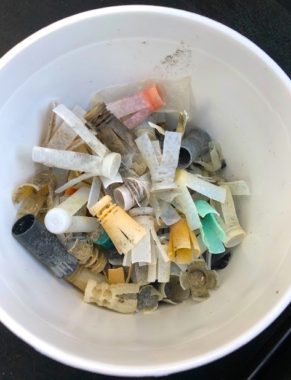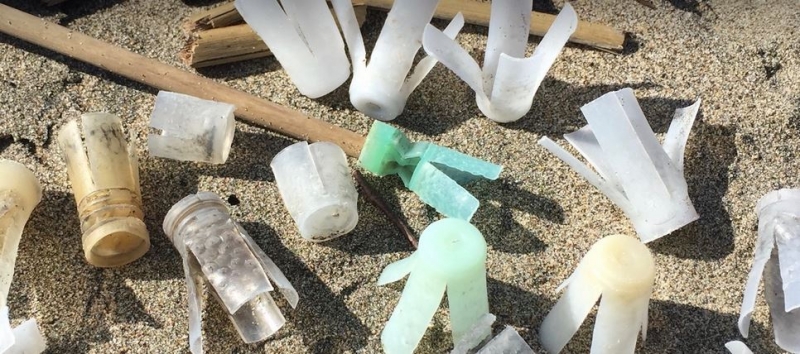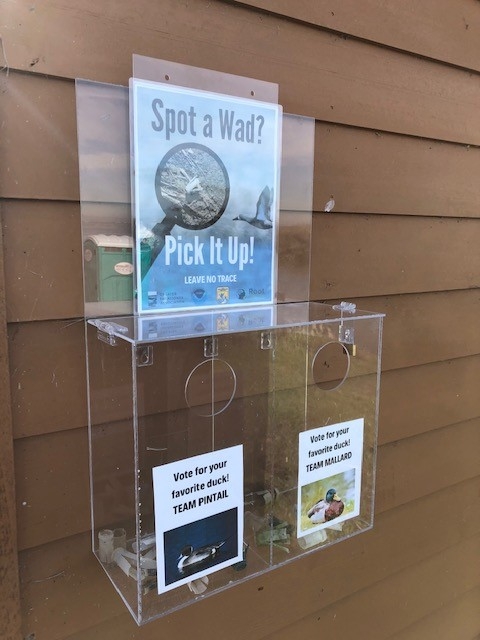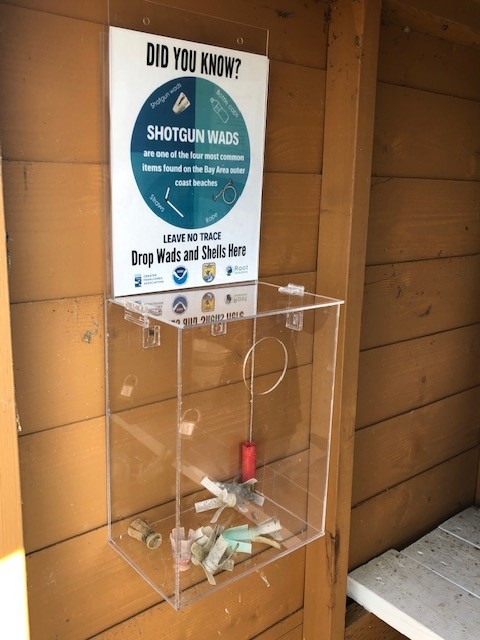The Greater Farallones National Marine Sanctuary (GFNMS) is one of the NOAA Marine Debris Programs’s (MDP) longest running Marine Debris Monitoring and Assessment Project (MDMAP) partners. Six years of data collection at locations along the Marin, San Francisco, and San Mateo county coastline revealed the types and frequency of marine debris on the surveyed shorelines, as well as one particularly interesting and problematic type of debris. The survey data indicated that shotgun wads, the plastic piece inside a shotgun shell that separates the shot from the powder, are one of the top ten most commonly found plastic items on all surveyed beaches. These shotgun wads likely come from waterfowl hunting, year-round shooting ranges, and target shooting fields along the San Francisco Bay and Delta. Wads eject up to 30 meters from the barrel of the gun, which makes them difficult to locate and properly dispose. When hunting nearby or over water bodies, as during waterfowl hunting, these wads end up in the environment and travel downstream and are deposited on the coastline. This issue is not unique to the San Francisco Bay, and has been identified in other parts of the country and world. The Surfrider Foundation’s “Wad Watcher” project has compiled reports of shotgun wads across North America, Europe, Asia, and Australia.

Because shotgun wad debris is so ubiquitous on the Sanctuary’s shorelines and there is no “silver bullet” or one solution to this problem, GFNMS, Greater Farallones Association, and Root Solutions came together, with funding from the NOAA Marine Debris Program, to try to tackle this issue by changing behaviors related to shotgun wads. The first step of this project was to interview hunters online and in person about their views on the problem of shotgun wads as marine debris, and their willingness to take action. The survey results showed that 80% of hunters were not aware that shotgun wad debris is an issue, and the same percentage were either somewhat or extremely concerned about the issue. This indicates that once they become aware of the issue, hunters are compelled to do something about it. Many hunters are ardent conservationists that want to maintain and protect habitats, and have no intention of adding to the marine debris problem. Removal of shotgun shells, which eject just a few feet from the gun chamber, has long been practiced by hunters. Now, thanks to this project they are aware of the presence and impacts associated with plastic wads and are primed to look for and remove these debris from our environment.
In California, there are few options for alternative ammunition, such as biodegradable wads, and there are state laws restricting the purchase of ammunition online. In order to encourage proper disposal of shotgun wads and reduce debris in the environment, disposal receptacles were installed at two local hunting reserves, Don Edwards San Francisco Bay National Wildlife Refuge and Eden Landing Ecological Reserve. The receptacles and accompanying signage were installed in early 2020 and are expected to remain in place during future waterfowl hunting seasons. They serve as a visual reminder to pick up wads, provide an easy disposal option, and raise awareness among the hunting community. Initial results from this pilot season and follow-up surveys of hunters who had access to the receptacles indicate that there is a willingness and desire among the hunting community to reduce their contribution to marine debris. In order to better understand the effectiveness of these measures, GFNMS is also continuing to conduct MDMAP surveys at four shoreline sites to track changes in the amount and types of marine debris found in the San Francisco Bayover time.
The “No Silver Bullet” project serves as a pilot marine debris prevention campaign customized for the hunting community. Results and recommendations can be scaled up and transferred to other parts of the U.S. that want to tackle the issue of shotgun wad debris, creating a future where hunters can enjoy their sport, protect the environment, and leave no trace.




What about the related problem of lead into the environment from the other part of shotgun shells? The current Administration made the use of lead shot on public lands legal again after the prior Administration solved this problem by outlawing lead shot on public lands & (some?) waters. Do national marine sanctuaries allow the use of lead shot within their boundaries? If so, why?